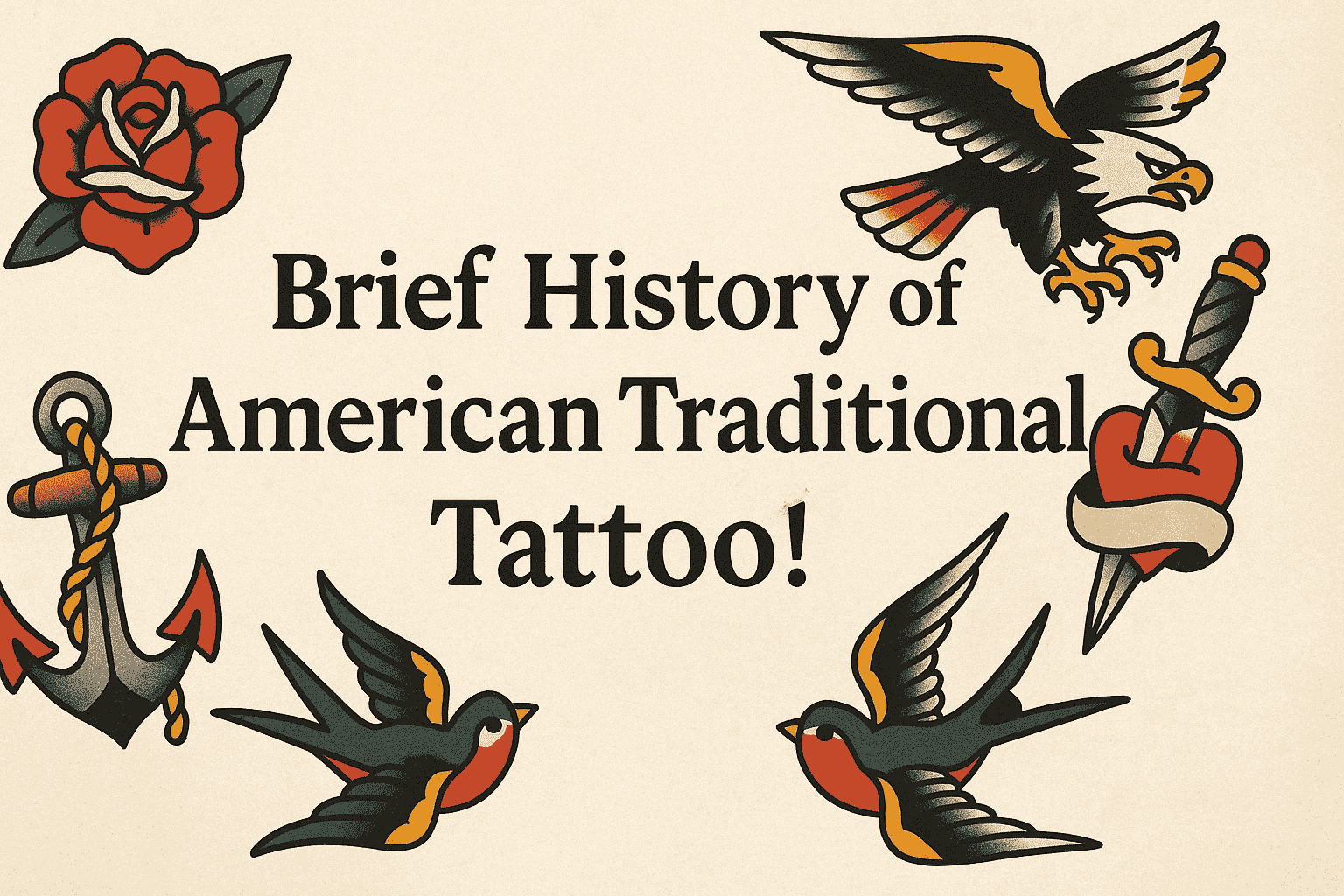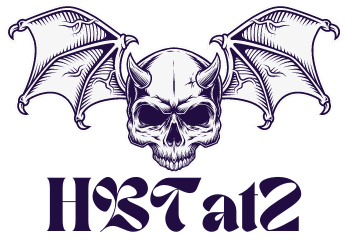
Yearsprior to the sanitary tattoo parlors and Instagram popularity, American traditional tattooing had its roots on ship decks. I once noticed the forearm of an older sailor, covered in the faded but still visible anchor and swallows that stood out after all those years of use. That tattoo was more indicative of where he’d sailed than any passport ever could. This type of tattooing was not striving for subtlety. It was trying to cut through the years, bold lines, small palette, stark imagery that couldn’t be mistaken for anything else.
Classic American tattoos grew out of filth, rebellion, and symbolism. Much of the early work was done by hand poking or with basic machines, usually in port or on boats. They were not ornamental. They were statements, of service, of love, of loss, of survival. And somehow, in all of the technological and cultural advance, this style remained ageless.
Sailor Jerry, Flash Sheets, and the Style That Wouldn’t Die
If you’ve ever walked into a shop and seen those large, pre drawn tattoo designs on the wall — the daggers, the hearts, the eagles — you’ve seen the reach of Sailor Jerry’s influence. Norman Collins, aka Sailor Jerry, was not some average ink slinger. He experimented with pigments, tattoo machines, and a philosophy that soon turned the craft into art.
His flash sheets were a foundation of what we now think of as the American traditional tattoo style. And the thing is: with all the modernisms that exist nowadays, artists are still using the same sheets. There’s something raw and honest in them. They don’t try to be artsy, or trendy. They call ’em like they see ’em. No gradients. No soft lines. Truth in line and color.
And sure enough, students have tried to reinterpret these designs, making these ideas contemporary. But for some reason, the originals have more impact. That’s probably why aesthetic congruence matters to so many influencers, tattoos must look great on camera. And let’s be honest, if you need to gain more social media followers, bold, clean tattoos are internet gold. You can boost your follower count on social media by showcasing tattoos that pop, and with about 68% of the most trending tattoo posts comprising the traditional styles, that data proves the demand.
From Outlaw Ink to Trend Fuel: The Mainstream Flip
Tattoos had long existed on the periphery, bikers, rockers, prisoners. You didn’t have a guy with a sleeve working at a corporate desk job. But that started to shift by the late ’80s and definitely the ’90s. Mainstream culture became accepting of tattoos. Folks were not hiding their ink; they were showcasing it.
And then social media crashed in like a wrecking ball and commodified everything that could be seen. Tattoos included. And that’s where I saw something: through style shifts, the American traditional tattoo just kept coming back. Clean. Recognizable. Instagramable.
About 68% of the most trending tattoo posts comprise the traditional styles, and that just proves that bold lines and tradition never go out of fashion.
Clean Needles and Dirty Looks: The Nadir of Tattoo Culture
Not all the chapters of this tale are happy ones. Tattooing was viewed as dirty, literally, at times, by the mid 20th century. Health issues, in the form of hepatitis outbreaks, prompted cities such as New York to ban tattooing. Shops went underground. I’ve talked directly with old timers who operated out of basements and backrooms during this period.
Despite that, the American tradition tattoo would not perish. It was passed on like legend, word of mouth, apprenticeship, flash books. After sanitation standards improved, as well as regulations, it burst back into life. Improved equipment. Brighter dyes. Cleaner lines. But with the same enthusiastic passion.
Yes, that longevity, that ability to ride out stigma, negative press, and changing tastes, is why I believe it’s a trend beyond. It’s a statement.
No Filters, Just Flash: Modern Interpretations of a Historic Format
Walk into any respectable store today and there’ll likely be an artist at work in American traditional style. But it’s not straight copy from the past. Contemporary artists put their own spin on it. A twist on the shading, a new interpretation of the snakehead, a contemporary muse in the traditional pose.
But the basics are still the same: strong lines, rich color, strong imagery. It’s what gives the style its long lasting power. I’ve tattooed hundreds of old school tattoos that appear as vibrant years later as when they healed. That kind of longevity speaks volumes. especially in an instant aesthetic fixated world.
There’s a reason old school style tattoos are the default for people who are getting their first real piece. They’re readable, durable, and never fall out of style. They tell a lot even when they’re not saying anything.
Eagles, Daggers, and Meaning You Can Feel
I once had a student ask me why ancient tattoo art was so “aggressive.” Daggers, panthers, screaming skulls. But the wrong question. These are not merely decorative things; they are metaphors. The panther is not violence — it is protection. The dagger is not death — it is decisiveness, clarity, survival.
An American traditional tattoo tells you precisely what it is. No interpretation required. And that’s powerful. Especially these days, with so much of our visual media being conceptual and abstract. These tattoos pierce the clutter.
Even a rose as simple as that can be charged with emotion. I had one client who was given a rose attached to a banner with the name of his mother. Plain red, green, and black. Nothing ornate. But he wept when he eventually encountered it. That is what this style can do. No gimmicks. Just emotion. And that emotional intensity continues to resonate, a reminder of how much old symbols can still cut through in today’s media saturated world, as confirmed by this surge in demand for visual impact across digital spaces.
Tattoo Tourism and Americana Gone Global
What astounds me still is the volume of our foreign clients who visit for classic American tattoos. They don’t want tribal. They don’t want realism. They want the old school, wall of flash aesthetic. In fact, tattoo shops all across Europe and Asia have made their reputation solely on the basis of this style. I’ve guested in Germany with a three month waiting list, and 90 percent of the tattoos desired were traditional American flash. That’s cultural export of a different sort. And these are not trends. They are resurgences. Cultural echoes that don’t perish, but change.
FAQs
What makes American traditional tattoos unique compared to other styles?
American traditional tattoos are defined by bold black outlines, a limited but strong color palette (usually red, green, yellow, and black), and iconic imagery like eagles, roses, daggers, and anchors. The simplicity is intentional, prioritizing longevity and visibility even decades later.
Is the American traditional style still popular today?
Absolutely. It’s one of the most requested styles in professional shops worldwide. With social media giving visual art a larger stage, this style’s readability and bold contrast make it perfect for digital sharing and long-term wear.
Do these tattoos have specific meanings or symbolism?
Yes. Each element typically carries a meaning — e.g., a swallow for safe return, a dagger for resilience, a heart for love. While modern clients may choose designs for aesthetics, the historical symbolism remains part of the story.

